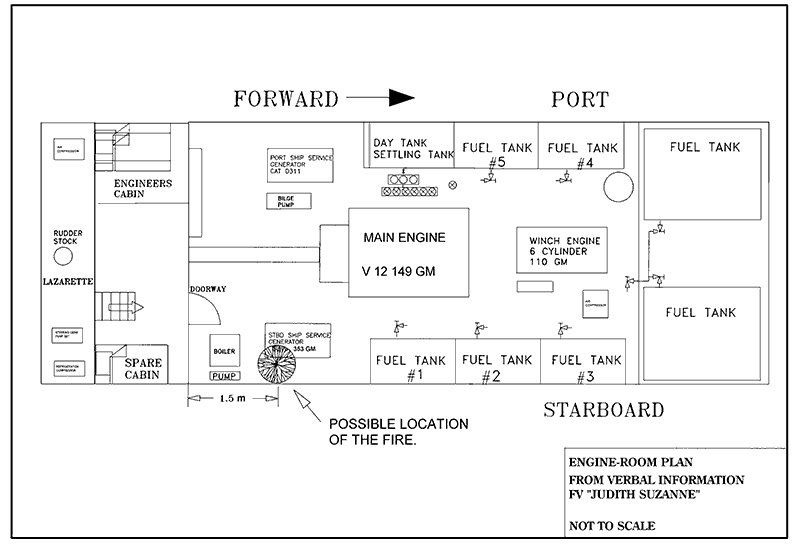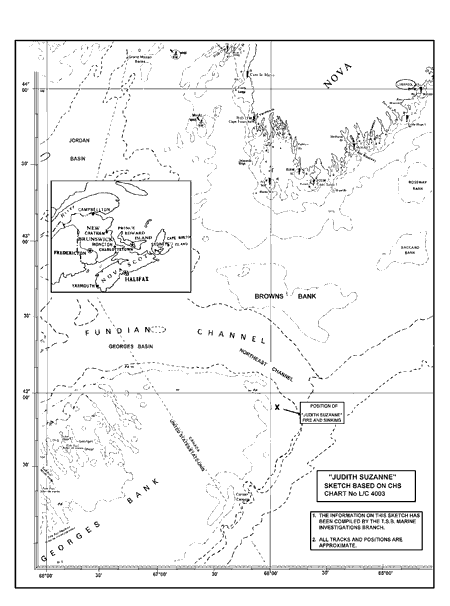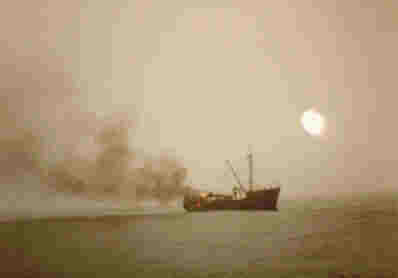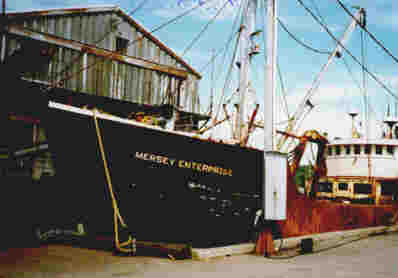Fire on board
and subsequent loss of the
F.V. JUDITH SUZANNE
Georges Bank, South-west of Nova Scotia
The Transportation Safety Board of Canada (TSB) investigated this occurrence for the purpose of advancing transportation safety. It is not the function of the Board to assign fault or determine civil or criminal liability. This report is not created for use in the context of legal, disciplinary or other proceedings. See Ownership and use of content. Masculine pronouns and position titles may be used to signify all genders to comply with the Canadian Transportation Accident Investigation and Safety Board Act (S.C. 1989, c. 3).
Summary
The "JUDITH SUZANNE" was trawling for scallops on Georges Bank, south-west of Nova Scotia, on 18 September 1993, when a fire broke out in the engine-room. Attempts to extinguish the fire were unsuccessful and the crew members were forced to abandon the vessel into liferafts. Weather conditions were calm. Another fishing vessel rescued the crew members and transported them safely back to Liverpool, Nova Scotia. The "JUDITH SUZANNE" sank later the same day.
The Board determined that the "JUDITH SUZANNE" was lost as a result of an engine-room fire of undetermined origin. The fire was not detected promptly because the compartment was not continually manned and the vessel was not fitted with a fire alarm system. The fire spread and intensified beyond the vessel's fire-fighting capabilities.
1.0 Factual Information
1.1 Particulars of the Vessel
| "JUDITH SUZANNE" | |
|---|---|
| Official Number | 319707 |
| Port of Registry | Liverpool, Nova Scotia |
| Flag | Canadian |
| Type | Wooden scallop trawler |
| Gross TonsFootnote 1 | 159.9 |
| Length | (registered)26.52 m |
| Built | 1963, Shelburne, Nova Scotia |
| Propulsion | One 700 BHPFootnote 2 eight-cylinder diesel engine driving a single propeller |
| Owners | Mersey Seafood Ltd. Liverpool, Nova Scotia |
1.2 Description of the Vessel
The hull of the "JUDITH SUZANNE" was transversely subdivided by wooden bulkheads into four compartments. Crew accommodation and store rooms were located in the compartment forward of the fish hold. Abaft the fish hold, the machinery space was located beneath the bridge structure which also housed the galley and other accommodation. The aftermost compartment contained further accommodation, store rooms, the lazaret and the steering flat.
No plans of the vessel could be located and information regarding the layout and the interior of the vessel is based on verbal information provided by the vessel's crew and shore staff (see Appendix A).
1.3 History of the Voyage
The "JUDITH SUZANNE" departed Liverpool, Nova Scotia, at about 1000Footnote 3, 17 September 1993, on what was intended to be a 10-day scallop fishing trip to the Georges Bank fishing grounds. At about 1230, 18 September, the master, who was on the bridge, smelled smoke. As he was about to investigate, a bang or minor explosion was heard from the direction of the engine-room followed quickly by the alarm indicating the imminent activation of the carbon dioxide (CO2) automatic fire-extinguishing system in the engine-room. Shortly before the alarm sounded, considerable electrical interference had been heard on a radio receiver. The vessel was stopped by using the wheel-house controls to take the main engine out of gear, and the CO2 cylinder storage area was checked to ensure that the cylinder had discharged properly.
There was only one access door to the engine-room. When it was opened to assess the situation, it could be seen that the fire was not fully extinguished. Two portable fire extinguishers were directed through the doorway at the seat of the fire which was observed to be in the area of the starboard generator. The smoke and flames were rapidly intensifying and preventing anyone from entering the engine-room to fight the fire; therefore, the engine-room door was closed so that the fire might extinguish itself through a lack of oxygen. The remote fuel shut-off valve was closed to stop the main engine and prevent fuel from feeding the fire.
It soon became apparent that the fire was out of control and the two inflatable liferafts were launched. Because of the increasing intensity of the fire and because there was no other means of fighting it, the decision was made to abandon the "JUDITH SUZANNE" and board the liferafts. The weather conditions were good with light airs and a slight sea and, despite fog restricting the visibility, the crew members were safely picked up by another fishing vessel about 20 minutes after casting off from the "JUDITH SUZANNE".
1.4 Injuries to Persons
None of the 17 crew members were injured in fighting the fire or abandoning the vessel.
1.5 Search and Rescue
Radio contact had been made with another fishing vessel, the "MERSEY ENTERPRISE", which was in the immediate area and which notified the Coast Guard Radio Station (CGRS) of the situation. The "MERSEY ENTERPRISE" was able to identify the radar target of the "JUDITH SUZANNE" and thus proceed directly to her position before sighting the liferafts and finally rescuing the crew.
1.6 Personnel
1.6.1 Watchkeeping System
The watch system consisted of six-hour shifts which were kept by all the crew members with the exception of the cook. The master, chief engineer and six deck-hands kept the 6-to-12 watches, and the mate, second engineer and the other six deck-hands, the 12-to-6 watches. During their watches, the master and the mate concentrated on the fishing operation and navigation, and the deck-hands attended to the fishing and scallop processing. The engineers periodically inspected and tended the engine-room; the balance of their watch was spent assisting the deck-hands. At the time the fire was discovered, it was the change of the watch. Although the engineers, in accordance with their usual practice, had discussed the watch change-over outside the engine- room and the engine-room was unmanned, the chief engineer had inspected the engine-room just before 1200 and found everything normal.
1.6.2 Crew Experience and Qualifications
All the crew members were experienced seamen and fishermen. The master had held that position on the "JUDITH SUZANNE" for 12 years and most of the others had served on the "JUDITH SUZANNE" for periods of 7 to 10 years. The master and mate held formal marine qualifications relative to their positions, and one of the deck-hands also held a formal marine qualification. The two engineers did not hold formal marine qualifications and they were not required to by regulation.
1.6.3 Crew Training
There is a regulatory requirement for vessels such as the "JUDITH SUZANNE" to hold drills covering safety matters at least once per month. However, the crew of the "JUDITH SUZANNE" had only been exercised in these drills when the Canadian Coast Guard (CCG) Ship Safety Branch made its annual inspection in connection with the renewal of the vessel's Steamship Inspection Certificate (SIC 31). "Emergency Station Bills" were posted in different parts of the vessel. These indicated the posts and duties of the various crew members in the event of an emergency. The owners regularly received CCG Ship Safety Bulletins, a number of which emphasize safety matters, but these were, reportedly, neither passed on to the vessel nor was any necessary implementation discussed with the master or crew. Reportedly, the owners held the master responsible for training the crew in all aspects of safety. The three who held formal marine qualifications were the only crew members who had attended Marine Emergency Duties (MED) courses which include instruction on fighting shipboard fires.
1.7 Seat of the Fire
The "JUDITH SUZANNE" was not considered salvageable. The vessel sank in some 40 fathoms (73 m) precluding any possibility of examining the wreck to determine the point of origin of the fire or examine the flame spread pattern. Testimony pointed to the fire having started in the area of the engine-room in which the starboard generator and the boiler were located.
1.8 Fire-fighting Equipment
The vessel's fire-fighting equipment and its installation met regulatory requirements and, in addition, a portable gasoline-operated pump was carried; however, with the exception of four portable, handheld extinguishers, all the equipment was located in the engine-room. The vessel was not fitted with a smoke- or fire-detection and alarm system nor was it required to by regulation.
The only alarm was associated with the heat-activated CO2 fire-extinguishing system in the engine-room. The system was controlled by a "rate-of-rise" heat detector which would activate with a large increase in temperature over a short period of time and could indicate a flash fire or an explosion. The system would not detect smoke or a fire in the initial stages. The alarm was intended as a warning to personnel that the compartment should be vacated. The system operated as designed and the gas was injected into the space about 28 seconds after the alarm sounded. It was apparent that the gas had caused the fire to initially reduce in intensity, but there was reintroduction of oxygen when the engine-room door was opened about three minutes later. The crew members used their shucking aprons to block engine-room ventilators to cut off the supply of oxygen to the fire instead of closing the baffles fitted for that purpose.
The "JUDITH SUZANNE" did not carry a breathing apparatus and this precluded anyone from entering the smoke-filled engine-room to fight the fire from close quarters.
There was no emergency fire pump outside the engine-room and all the operating pumps stopped when electrical power was lost. There was, therefore, no supply of water to fight the fire from either inside or outside the engine-room.
There is no regulatory requirement for a vessel such as the "JUDITH SUZANNE" to carry a breathing apparatus or to be equipped with an emergency generator located outside the engine- room.
1.9 Life-saving Appliances
The vessel's life-saving appliances met regulatory requirements. There was one additional immersion suit on board which was the personal property of one of the crew members and which he wore when he abandoned the vessel. The rest of the crew members wore lifejackets, but some threw immersion suits into the liferafts in case they would be required later. Because of the calm weather conditions, the abandonment consisted of boarding directly into the liferafts; the rescue took place in similar circumstances. None of the crew members had to enter the water on either occasion.
There were three Emergency Position Indicating Radio Beacons (EPIRBs) on board: one automatic float-free unit secured to the after side of the wheel-house, and two portable units located in the wheel-house. None of the EPIRBs were activated, the float-free unit was not thrown overboard, which would have prevented it from being damaged in the fire, and the portable units were not taken into the liferafts.
1.10 Vessel's Generators and Emergency Power
It was the practice on the vessel to run only one of the two diesel generators. The generators were run on alternate voyages, with the one not in use being held on stand-by, in reserve. The starboard generator was operating on this voyage. There was no record of major repairs having been carried out on the starboard generator and it had reportedly been running without any noticeable defect. Maintenance was carried out by shore personnel in accordance with the manufacturer's recommended schedule and no defects had been noted. The cause of the considerable electrical interference which was heard on a radio receiver shortly before the alarm sounded was not determined.
When the CO2 was introduced into the engine-room and oxygen was displaced, the main engine continued running but the diesel-operated generator and pumps stopped. All the vessel's lighting systems failed and, with no emergency generator outside the engine-room, interior lighting depended on battery-powered lamps fitted to bulkheads in various parts of the accommodation.
The vessel was fitted with a very high frequency (VHF) radiotelephone (R/T) and a single side band (SSB) R/T. To meet regulatory requirements for a reserve source of electrical energy, the VHF R/T was battery-powered for emergency operation. The longer range SSB R/T was not required to be and was not so fitted. This meant that the vessel's distress message sent on the battery-powered VHF R/T after the loss of power had to be relayed by another vessel to CGRS because it could not be received by a shore station when sent from Georges Bank.
2.0 Analysis
2.1 Cause of the Fire
The fire started in the engine-room, in the area in which the starboard generator and the boiler were located, but there was no conclusive evidence which would suggest that one of these two pieces of machinery may have been the cause of the fire. The electrical interference heard on the radio might suggest a malfunction of the generator's electrical components, and the explosion could be symptomatic of a problem with the furnace or a problem in the crankcase of the generator. However, sparking or a loose connection in any electrical circuit could have caused the electrical interference. The evidence was that the smoke could be smelled, and the fire had probably therefore started, before the explosion occurred. There was no other evidence linking the start of the fire to either the generator or the boiler; the precise cause of the fire was thus not determined.
2.2 Fighting the Fire
Fighting a shipboard fire by introducing a smothering medium into a compartment relies on efficient exclusion of oxygen from the compartment. On the "JUDITH SUZANNE", this was not done. The crew members' attempt to cut off the supply of air to the engine-room by using their shucking aprons to block the ventilation system would not have been as effective as closing the ventilator baffles. Furthermore, after the CO2 had been injected into the machinery space, insufficient time was allowed before the door was opened to check on the results. The fire, which had apparently been contained, was permitted a fresh supply of oxygen, allowing it to intensify until it was out of control. It cannot be stated with certainty that the fire would have been extinguished if the crew had waited longer, but the door was opened without allowing enough time for the fire to die out.
When the fire flared up again, the only means left to the crew to fight the fire was the four portable fire extinguishers which were located outside the engine-room. Without a breathing apparatus, which the vessel did not carry, the crew could not enter the CO2 and smoke-filled machinery space, and the only fire pump that could have been used outside the engine-room was stored in the engine-room.
2.3 Crew Training
Only three of the crew members on the "JUDITH SUZANNE" had taken a MED course and received the instruction on fighting shipboard fires provided by such a course. The practice of not holding regular emergency drills on the "JUDITH SUZANNE" meant that there was only a limited possibility of the other crew members acquiring any of the skills required to successfully fight a fire on board a ship.
3.0 Findings
- The outbreak of the fire was not noticed because the engine-room was not manned at the time.
- The vessel was not fitted with a fire- or smoke-detection and alarm system.
- The fire-fighting potential of the CO2 smothering system was offset by oxygen being reintroduced into the engine-room when the door was opened prematurely.
- The fuel supply to the main engine was not shut off promptly.
- The baffles in the engine-room ventilators were not closed.
- The vessel was not fitted with an emergency generator.
- The one pump that could have been used outside the engine-room was stored in the engine-room.
- Of the vessel's fire-fighting equipment, only four portable extinguishers were located outside the engine-room.
- The vessel did not carry a breathing apparatus.
- The crew had not been trained or drilled in shipboard fire-fighting techniques.
- The Emergency Position Indicating Radio Beacons (EPIRBs) were not utilized.
- When the main electrical power failed, the vessel's radiotelephone range for distress messages was limited.
3.1 Causes and contributing factors
The "JUDITH SUZANNE" was lost as a result of an engine-room fire of undetermined origin. The fire was not detected promptly because the compartment was not continually manned and the vessel was not fitted with a fire alarm system. The fire spread and intensified beyond the vessel's fire-fighting capabilities.
4.0 Safety Action
4.1 Safety Action Taken
It was evident that the crew's lack of formal training in Marine Emergency Duties (MED), such as fire-fighting techniques, contributed to the severity of this occurrence.
In its report on a 1991 occurrence (TSB report No. M91W1075), the Board expressed concern over inadequately trained personnel on fishing vessels contributing to the frequency and severity of marine occurrences, whether they are on watch, handling a catch, or operating emergency and safety systems. Further, as a result of its investigation into the sinking of the fishing vessel "STRAITS PRIDE II" in December 1990, the Board recommended that:
The Department of Transport ensure that personnel who regularly crew closed- construction fishing vessels receive formal training in life-saving equipment and survival techniques.
Transportation Safety Recommendation M92-06(issued March 1993)
A proposed amendment to the Canada Shipping Act (CSA) is now being developed that would require non-certificated personnel to undergo recommended training.
4.2 Safety Concern
4.2.1 Fires on Fishing Vessels
TSB records indicate that, between 1989 and 1993, there was, on average, 62 fires a year on board Canadian fishing vessels; over 50 per cent of these fires resulted in the loss of the vessel. During the same period, an average of 17 fires occurred in engine-rooms annuallyFootnote 4.
According to the Japanese classification society's (Nippon Kaiji Kyokai (NK)) Study Committee on the Prevention of Engine Room FiresFootnote 5, the most common hazard leading to engine-room fires is fuel spray from damaged pipes. This is supported by the data from Canadian occurrences involving fishing vessels. The major causes of engine-room fires reported in Canada include fuel or hydraulic fluid from broken pipes and fittings spraying on hot engine parts; faulty electrical systems; and uninsulated exhausts in contact with flammable materials. Moreover, the 1987 Canadian Coast Guard (CCG) study into Fishing Vessel SafetyFootnote 6 indicated that, for the period from 1982 to 1986 inclusive, the major reported causes of vessel losses were fire and explosion, which accounted for 381 occurrences. The study cited improperly installed and maintained heaters; incorrect fuse ratings for electrical circuits; improperly secured and/or fractured fuel lines; oil or gas in bilges; and improperly installed propane systems as the major reason for the fires.
Notwithstanding that the CCG has long recognized the hazards associated with fire on board fishing vessels and has issued several Ship Safety Bulletins on the subject (in 1984, 1985, and 1989), there continues to be a significant number of fires in the engine-room of fishing vessels. Given the aforementioned Canadian statistics and as a result of recent fires on large fishing vessels (such as the "JUDITH SUZANNE" and the 488 gross-ton fishing vessel "RALI II" (TSB Report No. M94M0020)), the Board is concerned about the extent to which engine-room fires on board vessels continue to cause significant losses in the Canadian fishing fleet. Hence, the Board will assess these types of occurrences with a view to determining the need for further safety action.
This report concludes the Transportation Safety Board's investigation into this occurrence. Consequently, the Board, consisting of Chairperson, John W. Stants, and members Zita Brunet and Hugh MacNeil, authorized the release of this report on .
Appendices
Appendix A - Engine-room Plan
Appendix B - Chart of the Area of the Occurrence
Appendix C - Photographs
Appendix D - Glossary
- ADT
- Atlantic daylight time
- BHP
- brake horsepower
- bulkhead
- vertical partition separating compartments
- CCG
- Canadian Coast Guard
- CGRS
- Coast Guard Radio Station
- CHS
- Canadian Hydrographic Service
- CO2
- carbon dioxide
- CSA
- Canada Shipping Act
- EPIRB
- Emergency Position Indicating Radio Beacon
- fathom
- nautical measure equal to six feet
- F.V.
- fishing vessel
- immersion suit
- One-piece, coverall-type suit, leaving only the wearer's face exposed, which provides thermal protection and has similar flotation characteristics to the standard lifejacket
- IMO
- International Maritime Organization
- lazaret
- Space above afterpeak between decks used as store room
- m
- metre(s)
- MED
- Marine Emergency Duties
- R/T
- radiotelephone
- SI
- International System (of units)
- SIC
- Steamship Inspection Certificate
- SSB
- single side band
- steering flat
- Compartment in the after part of the vessel above the rudder in which are located the steering engine, quadrant, etc.
- transverse
- Across the vessel at right angles to the fore-and-aft line
- TSB
- Transportation Safety Board of Canada
- UTC
- Coordinated Universal Time
- VHF
- very high frequency



